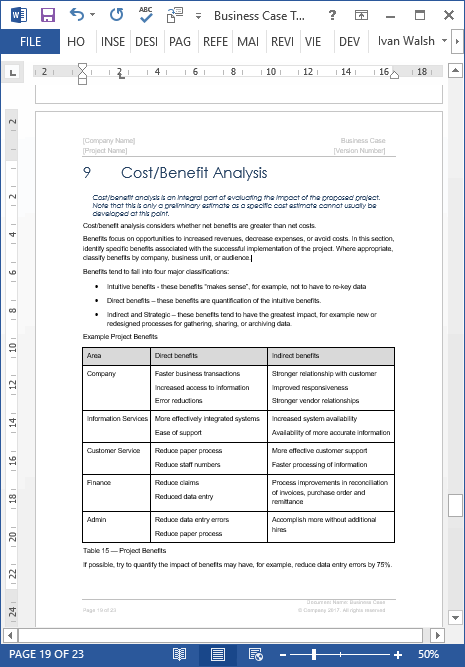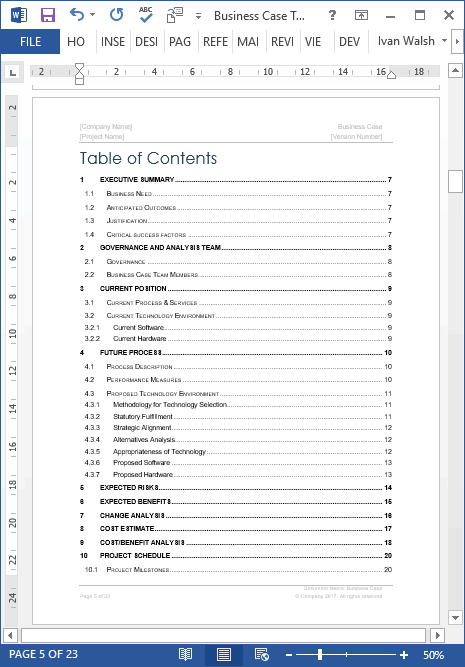Business Analysis Templates
How to Write a Business Case [Tutorial & Template]
Summary: A business case is a formal document that analyzes the costs, benefits and risks of a proposed project or initiative.
Share this article: Klariti
Topics: Business Writing. Business Case.
To improve your business case, substantiate the value proposition thorough market analysis, financial modeling, risk assessment, and ensuring your recommendations align with your strategic goals.
How do you write a business case? Well, there are two ways to write your first business case.
If you have enough knowledge, you can write the Business Case and send it to the Project Stakeholders for sign-off.
For more complex business analysis activities, you may need to write the Business Case with other team members by tapping into their expertise to write sections that use their respective strengths. In the following tutorial, we look at how to write a business case from scratch, this is, if you’ve never written a business case before and want to know where to start.
Click here to learn more about this Business Case template
What is a Business Case?
First, let’s define a business case.
Here are five definitions.
- A business case is a “tool that supports planning and decision making, including decisions about whether to buy and which products to bring to market.” Solutionmatrix
- The business case is where facts are documented and linked together into a cohesive story. Prosci.com
- A Business Case is used to obtain management commitment and approval for investment in business change programs. ogc.gov.uk
- Preparing a business case is part of the planning and fundraising process for community projects. omafra.gov.on.ca
- Business Cases are a deliverable for the Concept Phase. gov
When do you use a Business Case?
Next, when do you use a business case? In other words, what’s it’s purpose? Where does it fit into the project management lifecycle?
You can use a Business Case to ensure:
- Investment has value and importance
- Projects will be managed correctly
- Organization has the capability to deliver the benefits
- Resources will work on highest value opportunities
- Projects with inter-dependencies will be processed in the optimum sequence.
Business Case Goals
Look at the goals of the Business Case. Determine what type of answers this document needs to answer. In other words, if you identify what issues the Business Case should address, you can work backwards and provide the answers to these questions.
To do this:
- Make a list of all questions that need to be addressed.
- Assign a name to each question, for example, the Project Manager to answer scheduling questions or the IT Architect for technical issues.
- Send this list to the Project Stakeholder.
- Ask for permission to contact these individuals.
- Explain where they provide the information you need.
- Suggest alternatives should they be scheduled elsewhere.
- Estimate the amount of time you will require from them.
- Outline the risks involved if they are not able to assist with this task, e.g. incomplete estimates, incorrect figures, invalid project assumptions.
Business Case Example
You work for a small bank. One of the problems is the cost to handle checks. You’d prefer to move the customers to credit cards as it lowers the handling costs and lets you focus on high value actives.
To convince your management team that this is worth investing in, you need to show them where, why and how this will succeed. And this is why you need to create a business case.
The advantage of the business case is that it helps you:
- Justify why the investment will return the initial commitment.
- Show where there will be costs savings.
- Give examples of how this has worked before for others businesses.
What we are doing here is giving the decision makers enough information to weight up the pros and cons of the investment.
Where to Start
You can start the document by looking at the following:
- Outcomes – what benefits will the business gain by making this investment. Support this with case studies, white papers and other documentation.
- Justifications – you can then reinforce this by illustrating where the business will be more competitive as a result of starting the project. In the bank’s case, you could calculate how much you would save per customer by switching them from checks to credit cards.
- Obstacles – you also need to balance the document by showing the difficulties the project may encounter. In some ways this is where you win or lose the argument. If you can address the key problem points with reasonable responses, your business case will be more convincing to the project stakeholders.
Table of Contents
A suggested table of contents for your business case might include the following:
1 Executive Summary
1.1 Business Need
1.2 Anticipated Outcomes
1.3 Justification
1.4 Critical Success Factors
2 Governance and Analysis Team
2.1 Governance
2.2 Business Case Team Members
3 Current Position
3.1 Current Process & Services
3.2 Current Technology Environment
3.2.1 Current Software
3.2.2 Current Hardware
4 Future Process
4.1 Process Description
4.2 Performance Measures
4.3 Proposed Technology Environment
4.3.1 Methodology For Technology Selection
4.3.2 Statutory Fulfillment
4.3.3 Strategic Alignment
4.3.4 Alternatives Analysis
4.3.5 Appropriateness of Technology
4.3.6 Proposed Software
4.3.7 Proposed Hardware
5 Expected Risks
6 Expected Benefits
7 Change Analysis
8 Cost Estimate
9 Cost/Benefit Analysis
10 Project Schedule
10.1 Project Milestones
10.2 Assumptions
10.3 Constraints
10.4 Dependencies
11 Appendix
11.1 Glossary of Terms
11.2 Acronyms and Abbreviations

Click here to view the Cost-Benefits Analysis chapter
Business Case Metrics
Use the process of defining metrics to answer the following questions:
- Identify the primary business objectives, for example, reduce costs, increase sales, develop market share
- How to accomplish this, for instance, reducing labor and/or business costs associated with certain steps of a related process
- How to measure the effectiveness of the initiative, such as reduction in cost per unit of output for the process
Create the Writing Team
Once you get confirmation to contact them:
- Send a welcome email thanking them for joining the project.
- Outline the high level goals.
- Share examples of other Business Case documents.
- Arrange a workshop to show everyone what’’s involved and introduce team members.
- Share MS Word templates and show them how the templates are to be used.
- Walk the team through the review process so they all know their roles.
- Explain the reporting structure.
- Discuss the lines of communication and how/when to file status reports.
Once this stage is completed arrange sessions with each team member. This may only take one hour but should be used to answer questions they may not want to ask in public or have thought of after the initial session.
Business Cases that require a team effort need to be managed like any project. Don’’t assume that other Business Analysts know how to use the template correctly. Make yourself available to answer questions and help the team to write the document as efficiently as possible. Also, if you do need to edit others work, do so as sensitively as possible.
Your Business Case will identify the benefits you expect to gain by undertaking this project. Define business benefits in measurable terms as metrics are the cornerstone of any effort to deliver quantifiable value.
Developing the Business Case
Business benefits may be realized in different ways, such as:
- Increased market share
- Improve customer service
- Reduced customer complaints
- Less employee turnover and staff attrition
- Faster turnarounds for product development
- Higher sales numbers for new or existing products
Capturing Expected Benefits
The simplest way to capture the Expected Benefits is to create a table, either in your Microsoft Word or Excel template, and create three columns.
In the table create columns for:
- Benefit – identify the benefit you want to track
- Benefit measurement – discuss how will measure the benefit
- Benefit tolerance +/- – identify the tolerance when measuring the benefit
Qualitative v Quantitative
To make the Business Case more convincing to the readers, show how the project’s benefits will be delivered in measurable terms against the current situation.
Benefits should be:
- Qualitative
- Quantitative
- Conclusion
Benefits should be aligned your corporate strategy. Set tolerances for each benefit and for the aggregated benefit. Then close the document by identifying where they benefits will be realized during the project execution.
In the Executive Summary of your Business Case, you need to outline the Critical Success Factors which underpin your project. For example, give the readers different ways of judging how the project will be deemed successful should it reach the goals you have identified as success factors.
Learn more – Business Case writing tips and templates
Sample Critical Success Factors
Imagine you work in a call center. You decide to buy new Contact Management Software to speed up customer calls by 200% – this will one metric you can use to judge how successful the new software.
The success of the project would be how effective this system worked when handing X amount of calls within 24, 48 and 72 hours.
Capturing Critical Success Factors
Let’s look at how to capture Critical Success Factors and add these into the Business Case document.
In the call center, we’re going to add new software to respond to customer queries.
- If the software processes 1000 emails per hour, it fails the test
- If the software processes 2000 emails per hour, it passes the test at the lowest level
- If the software processes 5000 emails per hour, it passes the test at the highest level
In other words, the software is judged to be a success if it passes the success factors, which in this case would be 5000 emails per hour.
Who Identifies Success Factors?
The next point is who identifies the Critical Success Factors. This is worth examining as the team members who define the business rules are usually involved in defining Critical Success Factors.
This team – usually the project stakeholders – will look for the following:
- Where the new system can improve the existing processes
- How this can be achieved with the new software, service or tools
- How success can be measured against specific metrics.
Critical Success Factors are a fundamental part of every Business Case. To make the document as practical as possible, identify areas where you can measure the success of any new tool, product or service. This metric allows you to see in absolute terms where and how the investment is justified.
Justifying the Business Need
How to justify the need for a Business Case? To get started, explore the Business Needs as this is what drives the Business Case. Looking at it from this angle helps justify why there is a need to perform this task. Let’s look at a typical example.
Business Case shows why a project makes financial sense to your company. It helps project stakeholders with project planning and decision-making. For example:
- What products to buy
- What vendor to choose
- When to implement new solutions
Summary
Your readers look at the business case as a tool for making go/no go decisions. As a business writer, your role is to give them enough facts for them to make these calculations and decide whether to progress or not.
PS – Download the Business Case Template
It provides you with the structure you need to describe four main areas:
- Business Need – what is the specific need or gap in the market you are trying to target? Describe the business need that the project will address, for example, a new call center required to support customers requiring technical support.
- Anticipated Outcomes – describe the anticipated outcomes of implementing the project that addresses the business issue. Examples of outcomes should include answers to questions such as, “What are our aims?”, “How to define success factors?” and “What are the expected benefits?”
- Justification – describe why this project should be implemented and the rationale for why it was selected over other alternative solutions. Summarize key quantitative and qualitative information, including a description of the impact of not implementing the project.
- Critical Success Factors – describe and list the project’s critical success factors. Determine how success will be measured, for example, the percentage take-up of new services over [X] years.

Click here to view the Table of Contents
Share this article: Klariti
Topics: Business Writing. Business Case

